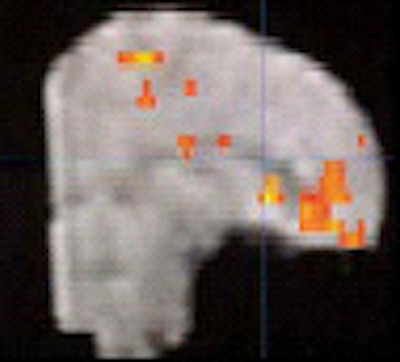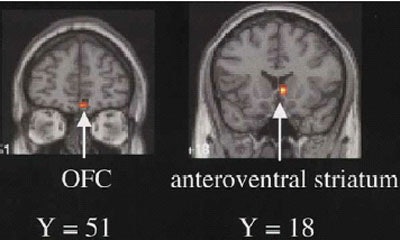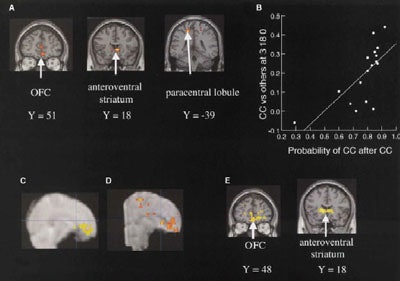
In a world where war and conflict are all too common, it's comforting to learn that cooperation brings rewards all its own. No less than an imaging study has found that humans get a kick out of working together for the common good.
This warm and fuzzy discovery was made by Dr. James Rilling and associates from the department of psychiatry and behavioral sciences at Atlanta's Emory University. The group began with the premise that human cooperation is everywhere, and must be explained. They ended up with fMRI images showing that activation of several brain regions peaked when the subjects cooperated (Neuron, July 18, 2002, Vol. 35, pp. 395-405).
Simple cooperation, such as that based on food sharing, is uncommon in the animal kingdom. Reciprocal altruism is even rarer, having been demonstrated in only a handful of species, Rilling and colleagues wrote. Researchers have attributed this scarcity to a need for several preconditions that must be met before reciprocal altruism can occur.
One is that individuals must interact repeatedly with their social partners. Two, they must be able to discriminate against those who don't cooperate. Finally, there must be a way to punish those who accept but don't reciprocate altruism -- in order to encourage cooperative behavior over the long term.
A well-established psychological research game called Prisoner's Dilemma was used to test the phenomenon of reciprocal altruism. In the study, letters were assigned to each type of behavioral occurrence for the pair of players. Each pair of subjects, all women, met briefly and then played several rounds of the game on computers while in the scanners. Sometimes the women were partnered with a computer instead of another woman.
Blood oxygen level-dependent (BOLD) fMRI was used to determine the degree of activation of regions of interest in the cerebral cortex in response to various event-related plots. A total of 36 women underwent fMRI in two separate experiments as they played the game. Men were excluded to ensure consistency, due to published reports indicating that they play the game differently.
The team used a 1.5-tesla MRI scanner (Philips Medical Systems, Best, Netherlands) to acquire T1-weighted structural images, as well as gradient-echo T2-weighted images with BOLD contrast. Axial slices, each 5 mm thick, were acquired of the entire brain volume in a plane parallel to the anterior-posterior commissural line (TR/TE 3000/40 ms, flip angle 90º, matrix 64 x 64). In an effort to minimize magnetic susceptibility artifacts in the orbitofrontal and medial temporal lobe regions, 27 6-mm slices were also acquired perpendicular to the anterior-posterior commissural line. Image data were corrected for motion, followed by spatial normalization.
SPM 99 analytical software (Wellcome Department of Cognitive Neurology, London, U.K.) was used to create a random-effects, events-related statistical analysis of the four choices of the trial: CC for mutual cooperation, CD or DC for one partner cooperating, and DD for neither cooperating.
When both human subjects cooperated (CC), they got $2 each; if both defected (DD), each got $1; if one player defected while the other played nice (CD or DC), the defector got $3 and the cooperator got nothing. The pairs did best by working together, but an individual could also get ahead by shafting a friend. Just like real life, in other words, except that the subjects were inside the scanner for the duration of the game.
"The first experiment was designed to isolate the neural correlates of cooperation and noncooperation in social and nonsocial contexts, and of monetary reinforcement of behavior," the authors wrote. But humans cooperated less (and reward centers were activated less) when they found out their partner was a computer.
"This motivated a second experiment in which 17 subjects were scanned during each of three game sessions, focusing specifically on human versus specific interaction."
 |
| Activation in player A when playing with an assumed human partner. Voxels activated for the interaction of player A and player B's choices (CC - CD) - (DC - DD) in Experiment 2 (p <0.01), after masking the results with voxels activated for the same contrast in Experiment 1 (p<0.01). OFC = ventromedial frontal/orbitofrontal cortex. Image and caption republished from Neuron, Vol. 35, pp. 395-405, with permission from Elsevier Science. |
Overall, the researchers found consistent interaction effects in fMRI. In the right caudate, the left post-central gyrus, the right central sulcus, and the right medial frontal gyrus, the neural response to game outcomes CC and DD combined was greater than activation following both CD and DC combined, they wrote.
This result corresponds to the idea that one partner's lack of cooperation is generally averse to the other, so the pattern is unlikely to be repeated. But when both partners either cooperated or both declined to cooperate (CC and DD), they tended to repeat the behavior.
The authors contrasted the BOLD fMRI response to cooperation, (which generated most of the interaction effect) with the average response of the other three outcomes combined. Responses to outcomes and decision-making were correlated with brain activation in the various regions. And several additional controls involving techniques such as open-ended games were used to prevent behavior based on external factors, such as changing behavior in anticipation of the end of a game.
 |
| (A) Voxels activated more by mutual cooperation (CC) than the mean of the other three outcomes in Experiment 2 (p < 0.01) after masking the results with voxels activated for the same contrast in Experiment 1 (p < 0.01). (B) Plot of contrast value for CC versus others in the peak voxel of the anteroventral striatal ROI against the probability of CC repeating in consecutive rounds for the 17 subjects in Experiment 2. (C and D) Statistical parametric map for the contrast in (A) displayed on a normalized EPI image for (C) Experiment 1 and (D) Experiment 2. Statistical images are thresholded at p < 0.01 (uncorrected). (E) Voxels showing a significant condition (human versus control) by monetary outcome ($2 versus others) interaction (p < 0.01), in which the response to $2 is greater for the social than the control condition. Data are for Experiment 1 only because the control condition was not included in Experiment 2. OFC = ventromedial frontal/orbitofrontal cortex. Image and caption republished from Neuron, Vol. 35, pp. 395-405, with permission from Elsevier Science. |
The group found that mutually cooperative social interactions in the game were associated with activation in the anteroventral striatum, rostral anterior cingulate cortex (ACC), and ventromedial frontal/orbitofrontal cortex (OFC), that were not associated with monetary reinforcement in a nonsocial control condition. That is, the rewards of social cooperation were more important than the money.
When the humans dealt with computers rather than human partners, however, the ACC and OFC were not activated, suggesting that the rewards were stronger and the reactions different when players knew their partners were human.
The activation patters suggested that the reaction to a partner's move and the decision over which move to make next both occurred in the few seconds following the display of results, which occurred 12 seconds after both partners' responses.
While choosing not to cooperate in response to a partner's cooperation was more profitable than mutual cooperation, the reward (as indicated by activation of the orbitofrontal and anteroventral striatal regions) was significantly reduced. This phenomenon may reflect guilt over having profited at the partner's expense, or perhaps fear of future retribution from a partner, the authors wrote.
A partner's refusal to cooperate also corresponded to deactivation of the anteroventral striatum in the cooperating partner. Conversely, receiving a partner's anticipated cooperation yielded a reward: activation of the obitofrontal cortex and ventral striatum in fMRI.
The most significant outcome of mutual cooperation (CC) was in the somatosensory association cortex in the medial posterior parietal lobe, suggesting somatic changes following mutual cooperation, the authors wrote. The decision to cooperate following a partner's cooperation was also associated with activation in the post-central gyrus.
The group concluded that reciprocal altruism is pervasive in human societies, and forms the foundations of interdependence on which the divisions of labor are based.
Still, partners' actions remain inherently unpredictable. The authors noted that the fMRI results were also consistent with longer-term feelings of trust and camaraderie, rather than expectations of future cooperation from a partner based on an act of cooperation.
"Indeed, some theorists have proposed that many of the social emotions have evolved in the service of preserving social relationships based on reciprocity," they wrote. "This agrees with the everyday observation that we often behave altruistically toward others simply because we like them, not because we consciously calculate that they are likely to reciprocate in the future."
By Eric BarnesAuntMinnie.com staff writer
August 22, 2002
Copyright © 2002 AuntMinnie.com


.fFmgij6Hin.png?auto=compress%2Cformat&fit=crop&h=100&q=70&w=100)





.fFmgij6Hin.png?auto=compress%2Cformat&fit=crop&h=167&q=70&w=250)











